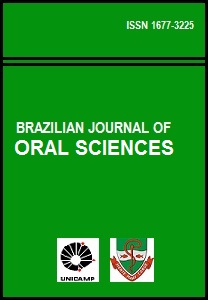Abstract
Temporomandibular disorders (TMD) characterize a heterogeneous group of conditions involving the temporomandibular joint (TMJ) and its contiguous tissues. Although the etiology and pathophysiology underlying the development of TMD have not been completely explained, the symptoms associated with these disorders are similar and are most commonly manifested as pain in the orofacial region. Despite the large body of literature on therapeutic modalities for TMD, this article briefly discusses the most common and current pharmacological clinical guidelines for managing TMD.References
Blank LW. Clinical guidelines for managing mandibular disfunction. Gen Dent. 1998; 46: 592-7.
National Institute of Dental and Craniofacial Research: Temporomandibular disorders. Availablre from: URL: http:// www.nidcr.nih.gov/health/pubs/tmd/main.htm [2004 Feb. 20].
Greene CH. Managing TMD patients: Initial therapy is the key. J Am Dent Assoc. 1992; 123: 43-5.
Solberg WK. Temporomandibular disorders: masticatory myalgia and its management. Br Dent J. 1986; 160: 351-6.
Jagger RG. Pharmacotherapy of masticatory system dysfunction. J Prosthet Dent. 1978; 40: 183-5.
Brazeau GA, Gremillion HA, Widmer CG, Mahan PE, Benson MB, Mauderli AP et al. The role of pharmacy in the management of patients with temporomandibular disorders and orofacial pain. J Am Pharm Assoc (Wash). 1998; 38: 354-63.
Andrade ED. Terapêutica medicamentosa em odontologia. São Paulo: Artes Médicas; 1998. p.184-8.
Simons DG. Myofascial pain syndromes due to trigger points: 2. Treatment and single-muscle syndromes. Manual Medicine 1985; 1: 72-77.
Lorenzetti BB, Ferreira SH. Mode of analgesic action of dipyrone: direct antagonism of inflammatory hyperalgesia. Eur J Pharmacol. 1985; 114: 375-81.
Quinn JH, Bazan NG. Identification of prostaglandin E2 and leukotriene B4 in the synovial fluid of painful, dysfunctional temporomandibular joints. J Oral Maxillofac Surg. 1990; 48: 968-71.
Hutchins B, Patel H, Spears R. Attenuation of pro-inflammatory neuropeptide levels produced by a cyclooxygenase-2 inhibitor in an animal model of chronic temporomandibular joint inflammation. J Orofac Pain. 2002; 16: 312-6.
Walsh TD. Antidepressants in chronic pain. Clin Neuropharmacol 1983;6(4):271-95.
Sharav Y, Singer E, Schmidt E, Dionne RA, Dubner R. The analgesic effect of amitriptyline on chronic facial pain. Pain. 1987; 31: 199-209.
Zitman FG, Linssen AC, Edelbroek PM, Stijnen T. Low dose amitriptyline in chronic pain: the gain is modest. Pain. 1990; 42: 35-42.
McQuay HJ, Moore RA. Antidepressants and chronic pain. BMJ. 1997; 314: 763-4.
McQuay HJ, Carroll D, Glynn CJ. Dose-response for analgesic effect of amitriptyline in chronic pain. Anaesthesia. 1993;48: 281-5.
Rizzatti-Barbosa CM, Nogueira MT, de Andrade ED, Ambrosano GM, de Barbosa JR. Clinical evaluation of amitriptyline for the control of chronic pain caused by temporomandibular joint disorders. Cranio. 2003; 21: 221-5.
Jagger RG. Diazepam in the treatment of temporomandibular joint dysfunction syndrome: a double blind study. J Dent. 1973; 2: 37-40.
The Brazilian Journal of Oral Sciences uses the Creative Commons license (CC), thus preserving the integrity of the articles in an open access environment.

